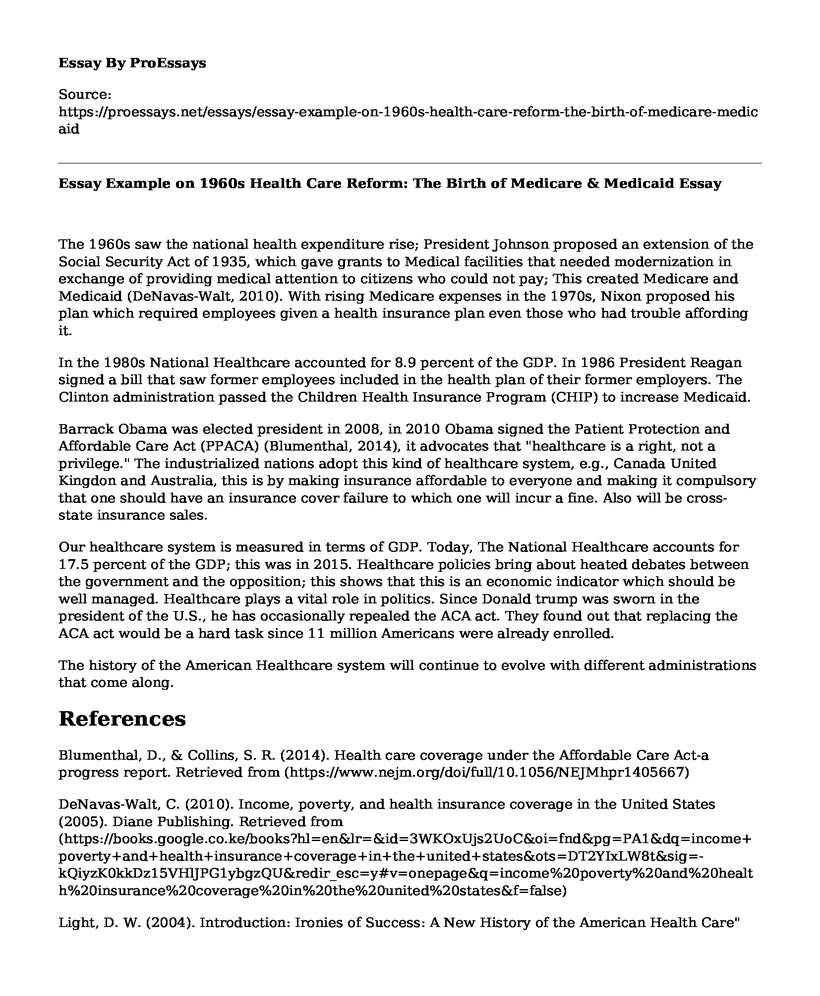The 1960s saw the national health expenditure rise; President Johnson proposed an extension of the Social Security Act of 1935, which gave grants to Medical facilities that needed modernization in exchange of providing medical attention to citizens who could not pay; This created Medicare and Medicaid (DeNavas-Walt, 2010). With rising Medicare expenses in the 1970s, Nixon proposed his plan which required employees given a health insurance plan even those who had trouble affording it.
In the 1980s National Healthcare accounted for 8.9 percent of the GDP. In 1986 President Reagan signed a bill that saw former employees included in the health plan of their former employers. The Clinton administration passed the Children Health Insurance Program (CHIP) to increase Medicaid.
Barrack Obama was elected president in 2008, in 2010 Obama signed the Patient Protection and Affordable Care Act (PPACA) (Blumenthal, 2014), it advocates that "healthcare is a right, not a privilege." The industrialized nations adopt this kind of healthcare system, e.g., Canada United Kingdon and Australia, this is by making insurance affordable to everyone and making it compulsory that one should have an insurance cover failure to which one will incur a fine. Also will be cross-state insurance sales.
Our healthcare system is measured in terms of GDP. Today, The National Healthcare accounts for 17.5 percent of the GDP; this was in 2015. Healthcare policies bring about heated debates between the government and the opposition; this shows that this is an economic indicator which should be well managed. Healthcare plays a vital role in politics. Since Donald trump was sworn in the president of the U.S., he has occasionally repealed the ACA act. They found out that replacing the ACA act would be a hard task since 11 million Americans were already enrolled.
The history of the American Healthcare system will continue to evolve with different administrations that come along.
References
Blumenthal, D., & Collins, S. R. (2014). Health care coverage under the Affordable Care Act-a progress report. Retrieved from (https://www.nejm.org/doi/full/10.1056/NEJMhpr1405667)
DeNavas-Walt, C. (2010). Income, poverty, and health insurance coverage in the United States (2005). Diane Publishing. Retrieved from (https://books.google.co.ke/books?hl=en&lr=&id=3WKOxUjs2UoC&oi=fnd&pg=PA1&dq=income+poverty+and+health+insurance+coverage+in+the+united+states&ots=DT2YIxLW8t&sig=-kQiyzK0kkDz15VHlJPG1ybgzQU&redir_esc=y#v=onepage&q=income%20poverty%20and%20health%20insurance%20coverage%20in%20the%20united%20states&f=false)
Light, D. W. (2004). Introduction: Ironies of Success: A New History of the American Health Care" System." Journal of Health and Social Behavior, 1-24. Retrieved from (https://www.jstor.org/stable/3653821?seq=1#metadata_info_tab_contents)
Cite this page
Essay Example on 1960s Health Care Reform: The Birth of Medicare & Medicaid. (2022, Dec 29). Retrieved from https://proessays.net/essays/essay-example-on-1960s-health-care-reform-the-birth-of-medicare-medicaid
If you are the original author of this essay and no longer wish to have it published on the ProEssays website, please click below to request its removal:
- Paper Example on Alzheimer's Disease
- Intervention for Children With Synethesia: The Girl Who Heard Colors Essay
- Scholar-Practitioner Project on Lung Cancer Paper Example
- Privacy: A Right or a Privilege in the Digital Age? - Essay Sample
- NAON: Professional Development for Orthopaedic Nurses - Essay Sample
- Essay Sample on US Government Upgrade of K-12 System: 3 Factors Needed
- Essay on Telemedicine: Washington DC to Provide Services via Husky Programs and Medicaid







